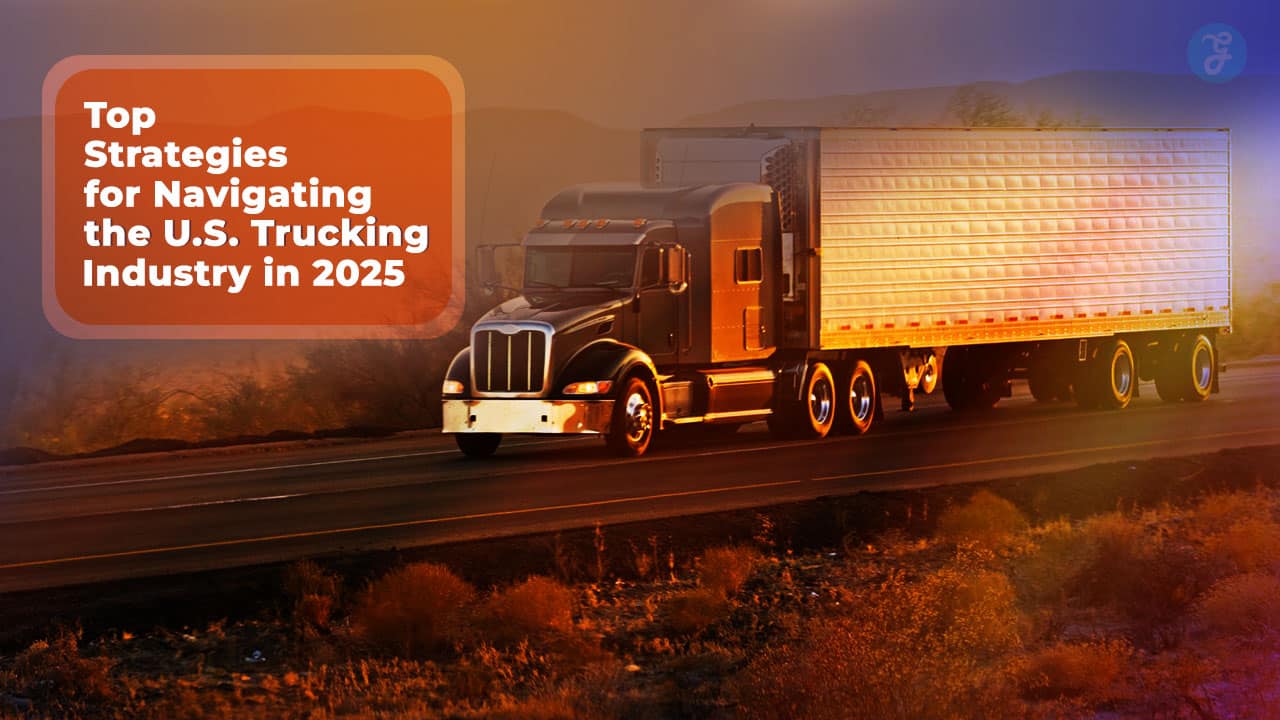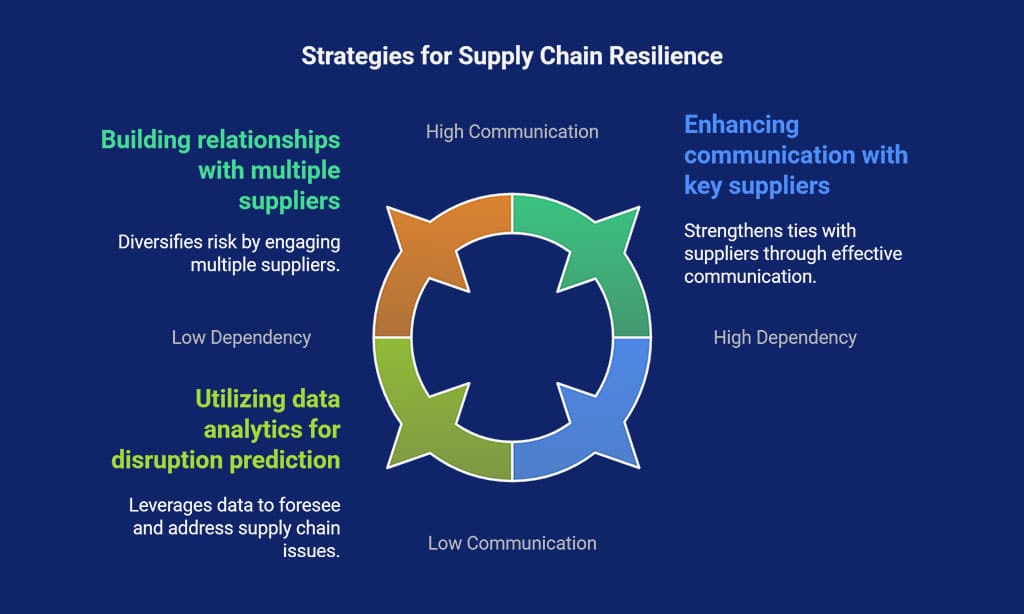The U.S. trucking industry remains the backbone of the nation’s supply chain, ensuring goods are transported efficiently across states and beyond.
However, the landscape is evolving due to regulatory changes, technological advancements, and shifts in market demand. To succeed in 2025, trucking professionals need well-thought-out strategies for navigating the U.S. trucking industry while adapting to new challenges.
This guide explores the best strategies for drivers, fleet owners, and logistics companies to thrive in a competitive market.
Understanding the Current Landscape of the U.S. Trucking Industry
Before implementing strategies for navigating the U.S. trucking industry, it’s essential to understand the market dynamics shaping the industry in 2025.
Key Trends Impacting the Trucking Industry:
- Regulatory Changes: Updates to Hours of Service (HOS) rules, emission standards, and insurance requirements.
- Rising Fuel Costs: The impact of fuel price fluctuations and alternative fuel adoption.
- Technology Integration: The role of artificial intelligence (AI), GPS tracking, and autonomous trucks.
- Driver Shortages: Addressing workforce challenges through recruitment and retention strategies.
- Supply Chain Disruptions: Managing delays and optimizing delivery efficiency.
Strategies for Navigating the U.S. Trucking Industry Successfully
The trucking industry in the U.S. is undergoing a significant transformation, influenced by emerging technologies, regulatory updates, and shifting economic conditions. To maintain a competitive edge, companies and drivers alike must embrace innovative solutions and best practices.
This section outlines essential strategies for navigating the U.S. trucking industry, ensuring efficiency, compliance, and long-term success.
1. Leveraging Technology for Efficiency
Technology plays a pivotal role in modern trucking operations, enhancing both efficiency and profitability. From real-time tracking systems to automated freight-matching platforms, technological innovations streamline workflows and reduce operational costs.
Advanced telematics provide insights into fuel consumption, driver behavior, and vehicle health, allowing companies to make data-driven decisions. As the industry continues to evolve, embracing the latest technological advancements will be crucial for maintaining competitiveness and ensuring compliance with new regulations.
| Technology | Benefits |
| Electronic Logging Devices (ELDs) | Ensures compliance with HOS regulations, reduces paperwork |
| GPS Tracking | Improves route optimization, enhances security |
| AI-Based Predictive Maintenance | Prevents costly breakdowns, extends vehicle lifespan |
| Freight Matching Apps | Connects shippers and carriers efficiently |
2. Optimizing Fleet Management
Effective fleet management is crucial for maintaining profitability while ensuring compliance with industry regulations. A well-managed fleet not only reduces operational costs but also enhances overall efficiency and safety.
Fleet owners must adopt proactive maintenance schedules, leverage data analytics for real-time monitoring, and implement route optimization techniques to minimize fuel consumption. Additionally, investing in driver training programs can enhance road safety, reduce accident-related expenses, and improve driver retention rates, which are critical for long-term business success.
Key Fleet Management Practices:
- Regular vehicle maintenance to prevent unexpected breakdowns.
- Implementing telematics for real-time fleet monitoring.
- Streamlining operations through automated dispatch systems.
3. Navigating Regulatory Compliance
Staying compliant with federal and state regulations is non-negotiable for trucking companies. With constantly evolving policies, companies must stay updated on new transportation laws, safety regulations, and environmental mandates.
Implementing a structured compliance program can help businesses avoid penalties, improve operational efficiency, and maintain a positive industry reputation. Adopting proactive strategies such as regular audits, compliance training for drivers, and leveraging regulatory tracking software can prevent legal and financial repercussions.
Key Compliance Areas:
- Understanding the latest Department of Transportation (DOT) regulations.
- Ensuring drivers meet CDL (Commercial Driver’s License) requirements.
- Adapting to changes in environmental regulations regarding emissions.
4. Managing Fuel Costs and Efficiency
Rising fuel prices impact trucking profitability, making it essential for companies to adopt comprehensive fuel management strategies. Implementing fuel-saving techniques not only reduces expenses but also improves overall fleet efficiency and sustainability.
From leveraging telematics for real-time fuel monitoring to adopting fuel-efficient driving practices, businesses can mitigate rising costs and enhance profitability.
Fuel Efficiency Strategies:
- Using aerodynamic truck designs to reduce drag.
- Encouraging fuel-efficient driving habits among drivers.
- Investing in alternative fuel vehicles (AFVs) or electric trucks.
5. Addressing the Truck Driver Shortage
The industry faces a persistent shortage of qualified drivers, creating significant challenges for logistics companies and fleet operators. With increasing freight demands and an aging workforce, companies must adopt innovative approaches to attract, train, and retain talent.
From improving compensation packages to offering career advancement opportunities, businesses need to make trucking a more appealing profession. Additionally, investing in better working conditions, mentorship programs, and financial incentives can help mitigate driver turnover and ensure a steady workforce.
Recruitment & Retention Strategies:
- Offering competitive salaries and benefits.
- Providing flexible scheduling to improve work-life balance.
- Investing in training programs for new and existing drivers.
6. Enhancing Cargo Security & Safety Measures
With cargo theft on the rise, companies must prioritize security protocols to protect assets and ensure safe deliveries. Implementing a multi-layered security strategy can significantly reduce the risk of theft and cargo loss. Utilizing advanced surveillance systems, real-time GPS tracking, and tamper-proof locking mechanisms on trailers can help deter criminal activity.
Additionally, conducting thorough background checks on employees, training drivers on security best practices, and establishing secure loading and unloading zones further enhance protection measures. Strong collaboration with law enforcement agencies and industry organizations also plays a crucial role in ensuring cargo security.
Security Enhancements:
- Installing advanced surveillance and alarm systems.
- Using tamper-proof seals and GPS-enabled locks on trailers.
- Training drivers on best practices for securing cargo during transit.
7. Improving Supply Chain Resilience
Supply chain disruptions, whether caused by natural disasters, geopolitical events, labor shortages, or unexpected market fluctuations, can significantly impact trucking operations. These disruptions lead to delivery delays, increased operational costs, and inefficiencies that affect the entire supply chain.
Companies must develop proactive strategies to mitigate risks and ensure business continuity, such as diversifying supplier networks, investing in predictive analytics, and enhancing real-time tracking systems to respond swiftly to unexpected challenges.
Key Strategies for Supply Chain Resilience:
- Building relationships with multiple suppliers to reduce dependency.
- Utilizing data analytics to predict and mitigate potential disruptions.
- Enhancing communication between logistics partners and customers.
8. Emphasizing Driver Health & Wellness
Truck drivers play a crucial role in ensuring smooth logistics operations, but their physically demanding job often comes at the cost of their health and well-being. Long hours on the road, irregular meal schedules, and sedentary lifestyles contribute to chronic health issues such as obesity, diabetes, and cardiovascular diseases.
Additionally, mental health concerns, including stress and isolation, further impact driver retention and performance. Companies that prioritize driver wellness not only improve employee satisfaction but also enhance overall efficiency and reduce accident risks.
Driver Wellness Strategies:
- Providing access to healthcare benefits and wellness programs: Employers should offer comprehensive healthcare plans, including regular medical check-ups, mental health support, and telemedicine services to ensure drivers receive timely medical assistance.
- Encouraging proper rest and sleep to avoid fatigue-related accidents: Implementing strict Hours of Service (HOS) compliance, providing adequate rest stops, and educating drivers on sleep hygiene can significantly reduce fatigue-related crashes.
- Offering incentives for maintaining healthy lifestyles and fitness: Employers can introduce wellness challenges, subsidized gym memberships, and nutritious meal programs to encourage healthier habits among drivers.
A healthy and satisfied workforce is essential for efficient trucking operations. Ensuring the well-being of drivers can reduce turnover rates and improve overall productivity.
Driver Wellness Strategies:
- Providing access to healthcare benefits and wellness programs.
- Encouraging proper rest and sleep to avoid fatigue-related accidents.
- Offering incentives for maintaining healthy lifestyles and fitness.
9. Implementing Data-Driven Decision Making
The trucking industry is increasingly leveraging data analytics to optimize operations, improve efficiency, and enhance customer service. Data-driven decision-making allows companies to predict demand, optimize fuel consumption, and improve asset utilization.
By integrating digital tools such as AI-powered logistics platforms and IoT-enabled tracking systems, trucking businesses can stay ahead of competitors and mitigate operational risks.
Data Utilization Strategies:
- Using predictive analytics for route planning and load optimization: AI-driven logistics software helps identify the most efficient routes, minimizing fuel costs and reducing delivery times.
- Tracking performance metrics to improve efficiency and safety: Monitoring key performance indicators (KPIs), such as driver behavior, fuel usage, and on-time delivery rates, allows companies to make informed business decisions.
- Implementing real-time data monitoring for proactive decision-making: IoT-enabled fleet tracking systems provide real-time insights into vehicle location, cargo conditions, and driver compliance, ensuring seamless operations.
Harnessing big data and analytics can help trucking companies optimize routes, reduce costs, and improve customer service.
Data Utilization Strategies:
- Using predictive analytics for route planning and load optimization.
- Tracking performance metrics to improve efficiency and safety.
- Implementing real-time data monitoring for proactive decision-making.
10. Expanding Business Through Diversification
Relying solely on one type of freight service can expose trucking companies to economic downturns and seasonal fluctuations. Expanding into diverse transportation services can create new revenue streams and build long-term resilience. By tapping into specialized markets, companies can increase profitability and mitigate risks associated with industry volatility.
Diversification Strategies:
- Offering specialized freight services like refrigerated or hazardous material transport: Investing in temperature-controlled or hazardous material transportation can attract high-paying contracts from industries such as pharmaceuticals, food supply chains, and chemicals.
- Expanding into last-mile delivery and e-commerce logistics: With the rise of online shopping, last-mile delivery services are in high demand. Partnering with e-commerce giants and local retailers can create steady revenue opportunities.
- Partnering with third-party logistics (3PL) providers for added efficiency: Collaborating with 3PL providers allows trucking businesses to leverage established networks, reduce operational costs, and improve overall service quality.
11. Investing in Autonomous Trucking Technology
Autonomous trucking is revolutionizing the transportation industry by leveraging advanced AI and machine learning technologies. These innovations are reshaping fleet operations, reducing costs, and improving safety. Autonomous trucks can operate with minimal human intervention, increasing efficiency and reliability.
Autonomous Trucking Benefits:
- Reduces Driver Fatigue and Improves Road Safety: Autonomous systems help prevent accidents caused by human error, fatigue, or distractions. AI-powered sensors and cameras continuously monitor road conditions, ensuring safer driving.
- Optimizes Fuel Efficiency Through AI-Driven Route Planning: Machine learning algorithms analyze traffic patterns, weather conditions, and fuel consumption to determine the most efficient routes, reducing fuel wastage.
- Lowers Long-Term Operational Costs for Fleet Owners: With reduced labor costs and increased efficiency, autonomous trucking provides significant long-term savings. Fewer accidents also mean lower insurance and repair costs.
12. Enhancing Sustainability Practices
As environmental concerns grow, the trucking industry is adopting sustainable practices to minimize its carbon footprint. Companies are investing in greener technologies and strategies to comply with regulations and appeal to eco-conscious customers.
Sustainability Initiatives:
- Investing in Electric and Hydrogen-Powered Trucks: Electric and hydrogen-fueled trucks reduce dependency on fossil fuels, cutting down carbon emissions and promoting cleaner energy use.
- Implementing Fuel-Efficient Driving Techniques: Training drivers on fuel-saving techniques such as optimized acceleration, reduced idling, and better load distribution helps conserve fuel.
- Using Eco-Friendly Logistics Practices to Reduce Emissions: Optimizing warehouse locations, reducing empty miles through backhauling, and adopting digital freight matching systems contribute to a greener supply chain.
13. Strengthening Customer Relations & Service Quality
In an increasingly competitive market, strong customer relationships and high service quality are key to business growth. Enhancing customer service fosters trust, leading to higher customer retention and brand loyalty.
Customer Service Strategies:
- Providing Transparent Tracking and Communication Tools: GPS tracking, automated notifications, and real-time updates allow customers to monitor their shipments and ensure better communication.
- Ensuring Timely and Damage-Free Deliveries: Efficient logistics planning and proper handling of goods prevent delays and damages, enhancing customer satisfaction.
- Offering Flexible and Customizable Logistics Solutions: Providing tailored shipping solutions, such as same-day delivery, personalized scheduling, and specialized handling, meets diverse customer needs.
14. Mitigating Legal Risks & Liabilities
The trucking industry is highly regulated, and compliance with legal standards is crucial to avoiding fines, lawsuits, and operational disruptions. Businesses must adopt proactive legal risk management strategies to stay compliant.
Legal Risk Management:
- Regularly Updating Policies to Comply with Transportation Regulations: Staying informed about local and international trucking laws ensures compliance with safety and operational standards.
- Conducting Routine Driver and Vehicle Inspections: Regular inspections help identify potential issues before they lead to accidents, reducing liability risks.
- Ensuring Adequate Liability Insurance Coverage: Having sufficient insurance protects against financial losses arising from accidents, cargo damage, or legal claims.
15. Adapting to Economic & Market Fluctuations
Economic conditions greatly impact the trucking industry, affecting freight rates, fuel prices, and demand for services. Businesses must adopt flexible strategies to remain resilient during economic downturns.
Economic Adaptation Strategies:
- Diversifying Client Portfolios to Minimize Revenue Loss During Downturns: Serving multiple industries reduces reliance on a single market, ensuring stable revenue even during economic fluctuations.
- Monitoring Economic Trends and Adjusting Service Pricing Accordingly: Keeping track of market conditions allows companies to adjust pricing strategies, ensuring competitiveness while maintaining profitability.
- Strengthening Financial Reserves to Withstand Market Fluctuations: Maintaining cash reserves and securing credit lines help businesses navigate financial uncertainties without disrupting operations.
By adopting these strategies, trucking companies can stay competitive, enhance sustainability, and manage risks effectively, ensuring long-term growth and success in the industry.
Future Outlook of the U.S. Trucking Industry
As the trucking industry evolves, companies that adopt the right strategies for navigating the U.S. trucking industry will remain competitive. Embracing digital transformation, sustainable fuel alternatives, and regulatory compliance will ensure long-term success in a rapidly changing market.
Takeaways
Navigating the complexities of the U.S. trucking industry requires a combination of strategic planning, technology integration, and adaptability.
By implementing these strategies for navigating the U.S. trucking industry, trucking professionals can optimize operations, stay compliant, and maximize profitability in 2025 and beyond.










































